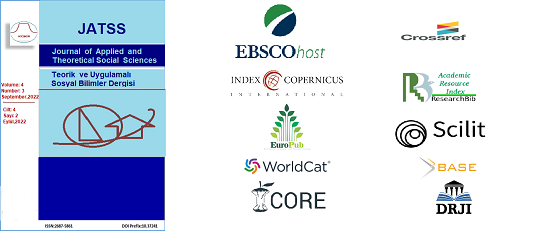Türkiye’de Yabancı Sermaye Yatırımlarının Uzun Dönemli Büyümeye Etkileri: İçsel Büyüme Teorisine Dayalı Ampirik Bir İnceleme
Özet
Bu çalışma, önce sermayenin geniş bir tanımı bağlamında Cobb-Douglas tipi bir üretim fonksiyonu ile temsil edilen bir içsel büyüme modelinden hareketle, sabit ve yabancı sermaye yatırımları ile ekonomik büyüme ilişkisini bir optimal kontrol problemi olarak tanımlamaktadır. Daha sonra bu problemin çözümü sonucunda üretilen basit bir basit büyüme eşitliği temelinde geliştirilen dört ampirik model çerçevesinde, Türkiye’de 1980-2020 dönemi için sabit sermaye yatırımı ve yabancı sermaye yatırımı olarak doğrudan yatırım, portföy yatırımı, diğer yatırım ve toplam yabancı yatırımın net sermaye giriş oranlarındaki değişmelerin kişi başına GSYH büyüme oranını uzun dönemde etkileyip etkilemediğini ARDL sınır testi yöntemini kullanarak araştırmaktadır. Elde edilen bulgular, sermaye yatırım oranları ve kişi başına GSYH büyüme oranı arasında eşbütünleşme ilişkisinin tanımlandığını, ancak sabit sermaye yatırımı ve farklı formlardan oluşan yabancı sermaye yatırımı oranlarındaki değişmelerin kişi başına GSYH büyüme oranını anlamlı olarak uzun dönemde etkilemediğini, ancak kısa dönemli etkilerin oluştuğunu göstermektedir.
##plugins.generic.paperbuzz.metrics##
Referanslar
Acemoglu, D., & Ventura, J. (2002). The World Income Distribution. Quarterly Journal of Economics, 117, 659–694. DOI: https://doi.org/10.1162/003355302753650355
Acemoğlu, D. (2009). Introduction to Modern Economic Growth. Princeton University Press.
Adams, S., & Klobodu, E. K. (2018). Capital Flows and Economic Growth Revisited: Evidence From Five Sub-Saharan African Countries. International Review of Applied Economics, 32(5), 620-640. DOI: https://doi.org/10.1080/02692171.2017.1355357
Aghion, P., & Howitt, P. (1992). A Model of Growth Through Creative Destruction. Econometrica, 60(2), s. 323-351. DOI: https://doi.org/10.2307/2951599
Aghion, P., & Howitt, P. (2009). The Economics of Growth. London: The MIT Press.
Aizenman, J., Jinjarak, Y., & Park, D. (2011). Capital Flows and Economic Growth in the Era of Financial Integration and Crisis, 1990-2010. Working Paper. National Bureau of Economic Research. https://www.nber.org. (Erişim: 01.08.2022). DOI: https://doi.org/10.3386/w17502
Akhtaruzzaman, M. (2019). International Capital Flows and the Lucas Paradox: Patterns, Determinants, and Debates. Singapore: Springer. DOI: https://doi.org/10.1007/978-981-13-9069-2
Arısoy, İ. (2011). Fiziksel Sermaye Yatırımları ve Büyüme İlişkisinin AK Modeliyle Sınanması: Türkiye Örneği (1968-2006). Maliye Dergisi, 161(2), s. 283-297.
Arrow, K. J. (1962). The Economic Implications of Learning by Doing. Review of Economic Studies, 29, 155–173. DOI: https://doi.org/10.2307/2295952
Ateş, S. (2013). Türkiye'de Fiziksel Sermaye Yatırımlarının Büyüme Oranına Uzun Dönemli Etkileri. Marmara Üniversitesi İktisadi ve İdari Bilimler Dergisi, 63-85.
Ateş, S., & Kaytancı, U. B. (2015). Türkiye'de Kamu Yatırım Harcamalarının Uzun Dönemli Büyümeye Etkileri. İ.Ü Siyasal Bilgiler Fakültesi Dergisi(52), s. 35-59.
Auerbach, A., Oliner, S. D., & Hassett, K. A. (1994). Reassessing the Social Returns to Equipment Investment. Quarterly Journal of Economics, 109(3), s. 789-802. DOI: https://doi.org/10.2307/2118422
Avşar, M. (2007). The causality relationship between economic growth and foreign direct investment in Turkey. Business & Economics Society International (B&ESI) Conference.
Bailliu, J. N. (2000). Private Capital Flows, Financial Development, and Economic Growth in Developing Countries. Canada: Bank of Canada Working Paper .
Barro, R. J., & Sala-i-Martin, X. (1992). Public Finance in Models of Economic Growth. Review of Economic Studies, 59(4), s. 645-661. DOI: https://doi.org/10.2307/2297991
Barro, R., & Sala-i-Martin, X. (1995). Economic Growth. Cambridge: McGraw-Hill.
Berber, M., Sivri, U., & Artan, S. (2001). İstanbul Üniversitesi Siyasal Bilgiler Dergisi, s. 61-70 .
Berument, M. H., Denaux, Z. S., & Emirmahmutoglu, F. (2015). The effects of capital inflows on Turkish macroeconomic performance. Empirica, 42(4), 813-824. DOI: https://doi.org/10.1007/s10663-015-9278-2
Borensztein, E., Gregorio, J. D., & Lee, J.-W. (1998). How Does Foreign Direct Investment Affect Economic Growth? Journal of International Economics, 45, 115–135. DOI: https://doi.org/10.1016/S0022-1996(97)00033-0
Brown, R. L., Durbin, J., & Evans, J. M. (1975). Techniques for Testing the Constancy of Regression Relationships over Time. Journal of the Royal Statistical Society, 37(2), s. 149-192. DOI: https://doi.org/10.1111/j.2517-6161.1975.tb01532.x
Choong, C.-K., Baharumshah, A. Z., Yusop, Z., & Habibullah, M. S. (2010). Private Capital Flows, Stock Market and Economic Growth in Developed and Developing Countries: A Comparative Analysis. Japan and the World Economy, 22, 107–117. DOI: https://doi.org/10.1016/j.japwor.2009.07.001
De Mello, L. R. (1997). Foreign direct investment in developing countries and growth: A selective survey. The Journal of Development Studies, 34(1), 1-34. DOI: https://doi.org/10.1080/00220389708422501
Demir, Ö. (2022). Ekonomik Büyüme ve Uluslararası Sermaye Akımları Üzerine Ampirik Bir İnceleme. Doktora Tezi. Adana: Çukuruva Üniversitesi.
Dickey, D. A., & Fuller, W. A. (1981). The Likelihood Ratio Statistics For Autoregressive Time Series With a Unit Root. Econometrica, 49(4), s. 1057-1072. DOI: https://doi.org/10.2307/1912517
Durham, J. B. (2003). Foreign Portfolio Investment, Foreign Bank Lending, and Economic Growth. International Finance Discussion Papers. Board of Governors of the Federal Reserve System. DOI: https://doi.org/10.2139/ssrn.382063
Durham, J. B. (2004). Absorptive Capacity and the Effects of Foreign Direct Investment and Equity Foreign Fortfolio Investment on Economic Growth. European Economic Review, 48, 285 – 306. DOI: https://doi.org/10.1016/S0014-2921(02)00264-7
Frankel, M. (1962). The Production Function in Allocation of Growth: A Synthesis. American Economic Review, 52, 995–1022.
Grossman, G. M., & Helpman, E. (1991). Innovation and Growth in the Global Economy. Cambridge: MIT Press.
İnsel, A., & Sungur, N. (2003). Sermaye Akımlarının Temel Makroekonomik Göstergeler Üzerindeki Etkileri: Türkiye Örneği –1989: III-1999: IV. Tartışma Metni. Türkiye Ekonomi Kurumu. http://www.tek.org.tr. (Erişim: 03.09.2022).
Jones, C. I. (1995). Time Series Tests of Endogenous Growth Models. The Quarterly Journal of Economics, 110(2), 495-525. DOI: https://doi.org/10.2307/2118448
Jones, L., Manuelli, R., & Stacchetti, E. (2000). Technology and Policy Shocks in Models of Endogenous Growth. Federal Reserve Bank of Minneapolis Working Paper. DOI: https://doi.org/10.21034/sr.281
King, R. G., & Rebelo, S. (1990). Public Policy and Economic Growth: Developing Neoclassical Implications. Journal of Political Economy, 98, 126–150. DOI: https://doi.org/10.1086/261727
Li, D. (2002). Is the AK Model Still Alive? The Long-Run Relation between Growth and Investment Re-Examined. Canadian Journal of Economics, 35, s. 92-114. DOI: https://doi.org/10.1111/1540-5982.00122
Li, X., & Liu, X. (2005). Foreign Direct Investment and Economic Growth: An Increasingly Endogenous Relationship. Worm Development Vol. 33, No. 3, pp. 393-407, 2005, 33(3), 393-407. DOI: https://doi.org/10.1016/j.worlddev.2004.11.001
Long, B. D., & Summers, L. H. (1991). Equipment Investment and Economic Growth. The Quarterly Journal of Economics, 106(2), s. 445-502. DOI: https://doi.org/10.2307/2937944
Lucas, R. (1990). Why Doesn’t Capital Flow from Rich to Poor Countries? American Economic Review, 80, 92-96.
Lucas, R. E. (1988). On the Mechanics of Economic Development. Journal of Monetary Economics, 22, 3-42. DOI: https://doi.org/10.1016/0304-3932(88)90168-7
Lütkepohl, H. (1991). Introduction to multiple time series analysis. Heidelberg: Springer-Verlag Berlin. DOI: https://doi.org/10.1007/978-3-662-02691-5
Mankiw, N. G., Romer, D., & Weil, D. N. (1992). A Contribution to the Empirics of Economic Growth. Quarterly Journal of Economics, 107(2), s. 407-437. DOI: https://doi.org/10.2307/2118477
McKinnon, R. I. (1973). Money and Capital in Economic Development. Washington, DC: The Brookings Institution.
Pagano, M. (1993). Financial Markets and Growth: An Overview. European Economic Review, 613-622. DOI: https://doi.org/10.1016/0014-2921(93)90051-B
Pesaran, M. H., Shin, Y., & Smith, R. J. (2001). Bounds Testing Approaches to the Analysis of Level Relationships. Journal of Applied Econometrics, 289–326. DOI: https://doi.org/10.1002/jae.616
Phillips, P., & Perron, P. (1988). Testing for a Unit Root in Time Series Regression. Biometrika, 75(2), s. 335 346. DOI: https://doi.org/10.1093/biomet/75.2.335
Ramírez, M. (2000). Foreign Direct Investment in Mexico: A Cointegration Analysis. The Journal of Development Studies, 37(1), 138-162. DOI: https://doi.org/10.1080/713600062
Rebelo, S. (1991). Long-Run Policy Analysis and Long-Run Growth. Journal of Political Economy, 99(3), 500–521, 99(3), 500–521. DOI: https://doi.org/10.1086/261764
Romer, P. (1986). Increasing Returns and Long-Run Growth. Journal of Political Economy, 94, 1002–1037. DOI: https://doi.org/10.1086/261420
Romer, P. (1990). Endogenous technological change. Journal of Political Economy, 98(52), 71–102. DOI: https://doi.org/10.1086/261725
Shaw, E. S. (1973). Financial Deepening in Economic Development. New York: Oxford University Press.
Solow, R. M. (1956). A Contribution to The Theory of Economic Growth. The Quarterly Journal of Economics, 70(1), 65–94. DOI: https://doi.org/10.2307/1884513
Soto, M. (2000). Capital Flows and Growth in Developing Countries: Recent Empirical Evidence. OECD Development Centre Working Papers. https://www.oecd.org. (Erişim: 10.08.2022).
Swan, T. W. (1956). Economic growth and capital accumulation. Economic Record, 32(2), 334–361. DOI: https://doi.org/10.1111/j.1475-4932.1956.tb00434.x
Şıklar, İ., & Kaya, A. (1998). Türkiye’de Özel Sektör Yatırımları ve İçsel Büyüme. Ekonomik Yaklaşım, 9, s. 61-70.
Temiz, D., & Gökmen, A. (2013). FDI inflow as an international business operation by MNCs and economic growth: An empirical study on Turkey. International Business Review, 23(1), s. 145-154. DOI: https://doi.org/10.1016/j.ibusrev.2013.03.003






















